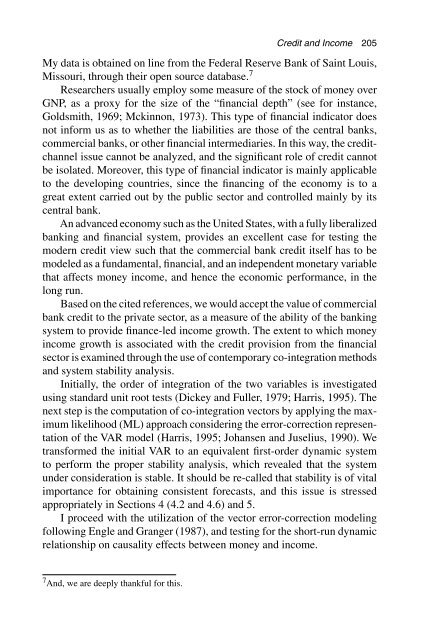Economic Models - Convex Optimization
Economic Models - Convex Optimization
Economic Models - Convex Optimization
Create successful ePaper yourself
Turn your PDF publications into a flip-book with our unique Google optimized e-Paper software.
Credit and Income 205<br />
My data is obtained on line from the Federal Reserve Bank of Saint Louis,<br />
Missouri, through their open source database. 7<br />
Researchers usually employ some measure of the stock of money over<br />
GNP, as a proxy for the size of the “financial depth” (see for instance,<br />
Goldsmith, 1969; Mckinnon, 1973). This type of financial indicator does<br />
not inform us as to whether the liabilities are those of the central banks,<br />
commercial banks, or other financial intermediaries. In this way, the creditchannel<br />
issue cannot be analyzed, and the significant role of credit cannot<br />
be isolated. Moreover, this type of financial indicator is mainly applicable<br />
to the developing countries, since the financing of the economy is to a<br />
great extent carried out by the public sector and controlled mainly by its<br />
central bank.<br />
An advanced economy such as the United States, with a fully liberalized<br />
banking and financial system, provides an excellent case for testing the<br />
modern credit view such that the commercial bank credit itself has to be<br />
modeled as a fundamental, financial, and an independent monetary variable<br />
that affects money income, and hence the economic performance, in the<br />
long run.<br />
Based on the cited references, we would accept the value of commercial<br />
bank credit to the private sector, as a measure of the ability of the banking<br />
system to provide finance-led income growth. The extent to which money<br />
income growth is associated with the credit provision from the financial<br />
sector is examined through the use of contemporary co-integration methods<br />
and system stability analysis.<br />
Initially, the order of integration of the two variables is investigated<br />
using standard unit root tests (Dickey and Fuller, 1979; Harris, 1995). The<br />
next step is the computation of co-integration vectors by applying the maximum<br />
likelihood (ML) approach considering the error-correction representation<br />
of the VAR model (Harris, 1995; Johansen and Juselius, 1990). We<br />
transformed the initial VAR to an equivalent first-order dynamic system<br />
to perform the proper stability analysis, which revealed that the system<br />
under consideration is stable. It should be re-called that stability is of vital<br />
importance for obtaining consistent forecasts, and this issue is stressed<br />
appropriately in Sections 4 (4.2 and 4.6) and 5.<br />
I proceed with the utilization of the vector error-correction modeling<br />
following Engle and Granger (1987), and testing for the short-run dynamic<br />
relationship on causality effects between money and income.<br />
7 And, we are deeply thankful for this.
















